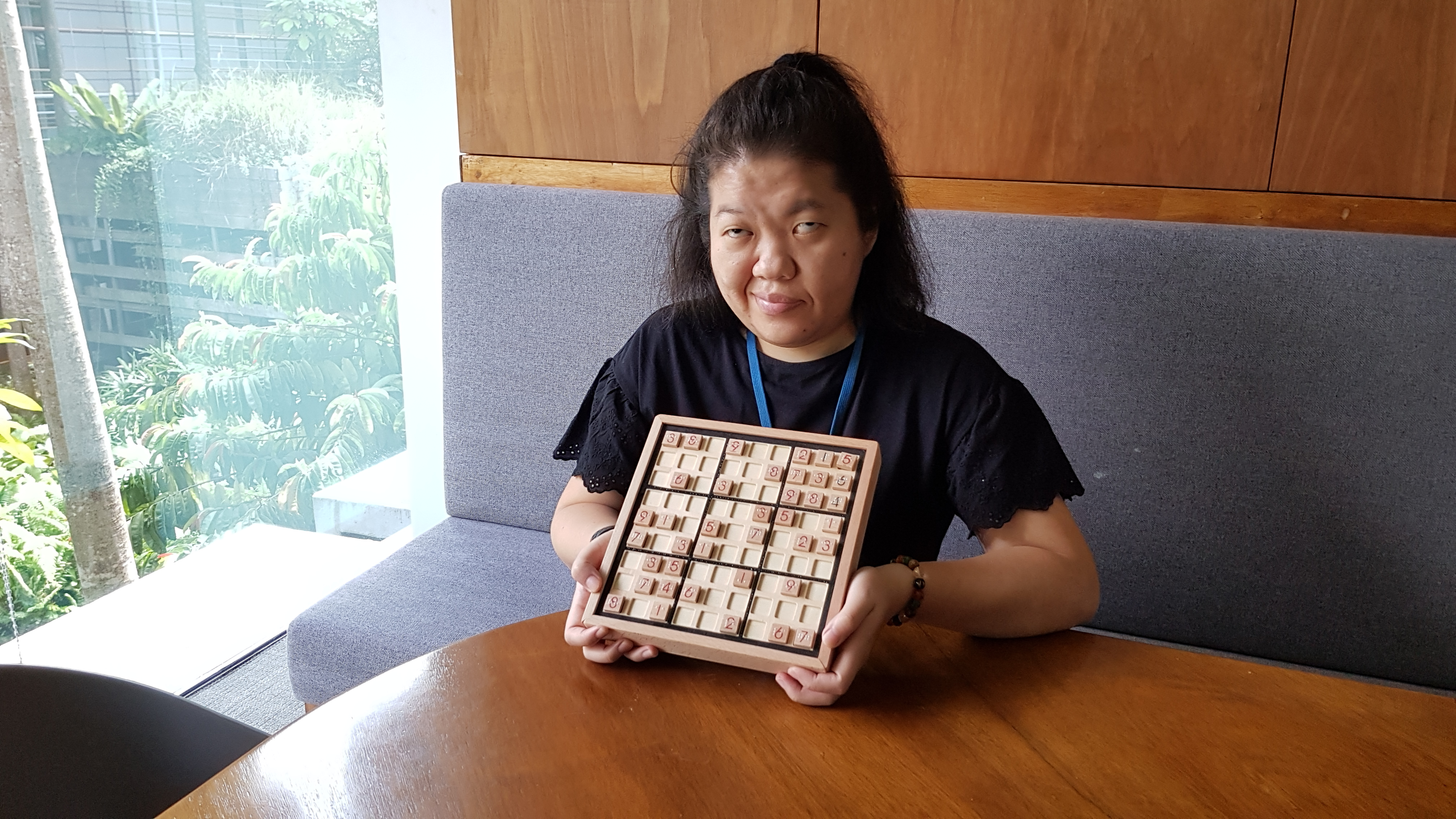
Siew Ling posing with her adapted Sudoku set
“Project Adaptive Fun” is an article series in which Siew Ling, who is deaf-blind, shares the simple adaptations she and her team have made to increase the accessibility of games! This is the first article of the series.
In Sudoku, the objective is to fill a 9-by-9 grid with numbers from 1 to 9 such that each column, row, and 3-by-3 sub-grid (or square) contains all the numbers without any repetition.
A few years ago, a friend bought me a braille Sudoku board and a braille puzzle book containing 100 puzzles with levels ranging from easy to hard. The Sudoku board is a wooden one, with each side 25cm long. It has 9 rows and 9 columns of round holes where plastic, colour-coded pegs, representing the numbers of the puzzle, can be inserted. These pegs have a diameter of about 2.5cm each and are labelled 1 to 9, with corresponding tactile braille marked for their respective colours.
-sudoku-(colourful)-(cropped)-(3_2)-ok.jpg?sfvrsn=6586f149_1)
A completed Sudoku board with colour-coded pegs placed on a 9-by-9 grid.
On each peg, there is a small white protruding pin in the middle which can be pushed in or out. Pegs representing numbers that are part of the original puzzle will be left protruding while the pegs placed as solutions by the player will be pushed down.
However, the pegs are hard to fit into the holes as some of their tips are thicker than the diameter of the holes. Being plastic pegs, some even cracked under the force I applied on them!
By the time I completed one puzzle, I had blisters on my fingers!
-20220616_144123-(cropped-with-brailler)-3_2-(ok).jpg?sfvrsn=1a4a97_1)
Photo of Siew Ling attempting to solve the Sudoku with the Wooden Sudoku set with drawer, and feeling the braille labelled on one of the number tiles. The bottom-right corner shows a smaller photo of a handheld braille labeller with a dial in white and braille labelled around it, with a handle in black.
For a less painful playing experience, we made adaptations to a store-bought wooden Sudoku set with a drawer, as shown in the photo above. The wooden number tiles are square-shaped, as are the holes on the board in which the tiles are placed.
- To mark out the nine 3-by-3 sub-grids, we pasted tape in between the sections to create a more tactile feel.
- To add braille labels on the number tiles, we used a handheld braille labeller (pictured above) which works similarly to the conventional tape labeller.
- Each tile comes with a number printed in black on one side and red on the other. Braille labels are pasted on both sides, with a slight modification to differentiate them. The side with the black number is used to represent the original puzzle, while the side with the red number is used for the player’s solution.
While the braille labels help with number identification, the labelled tiles cannot lie flat and will wobble slightly inside the square-shaped holes.
Nevertheless, this is definitely a better alternative than blistered fingers caused by the previous Sudoku board with its protruding pins and stubborn pegs.
While this modification took us some time and effort to create, it is a relatively simple innovation. Thanks to this, I can play Sudoku quite comfortably now, and so can you!
If you are a person with visual impairment who has always wanted to play puzzle games like Sudoku, try these adaptations out, or experiment with different materials to see what works best for you. Have fun experimenting!
Tan Siew Ling is fully Deafblind, having lost both her sight and hearing to a neurological condition, Neurofibromatosis type 2 (NF2). She carries a screen reader with a Braille display, which she fondly names “Bear Bear”, everywhere she goes. Her humour, wordplay, and love of puns keep friends on their toes. She enjoys reading books in her free time and loves to pen down her thoughts, often on a whim, which can be entertaining at times, on her social media. When she is not writing or reading, she can be seen doing insane 72kg leg presses or swinging a 20kg kettlebell to and fro. You can find out more about Siew Ling and her journey here.